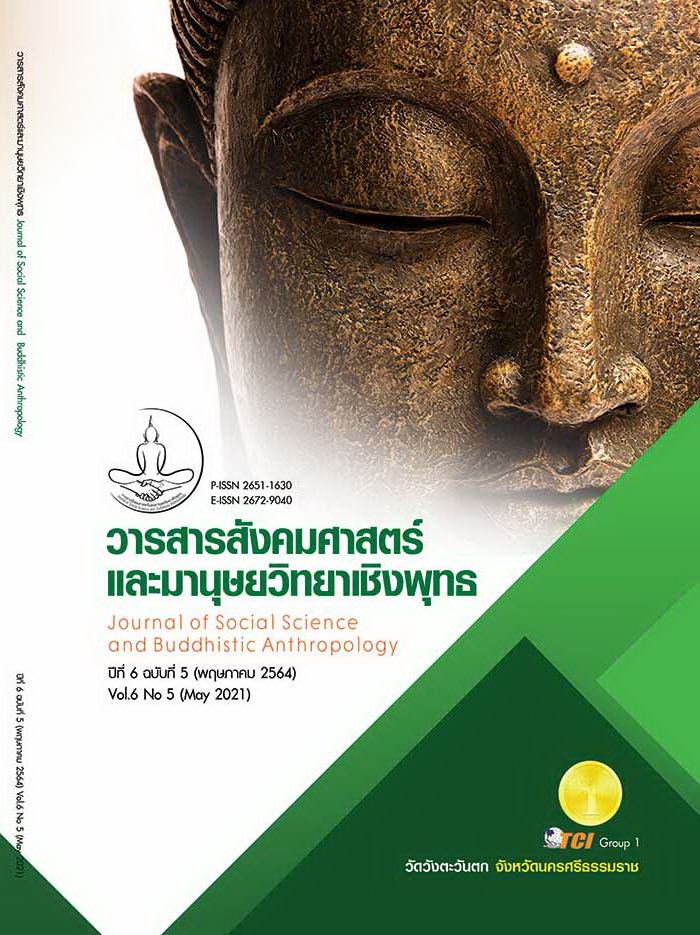CYBER BULLYING BEHAVIORAL AND RELATED FACTORS OF HIGH SCHOOL STUDENTS IN MUENG DISTRICT CHIANGRAI PROVINCE
Keywords:
High School Students, Bullying Behavioral, CyberAbstract
The objectives of this article were to study cyberbullying behavior and related factors among high school students in Muang District. Chiang Rai. The descriptive research collected from 450 samples which selected by using the stratified random sampling method. The research instruments were 1) the personal information record 2) the cyber bullying behavior questionnaires 3) the questionnaire of related influencing factors to the occurrence of bullying behaviors in the cyber world. The data was analyzed by descriptive statistics and Pearson product moment correlation coefficient. The study results found that high school students had the significant score of cyber bullying behavior in particular gossiping or flaming others on social networks (1.77) and deleting or blocking others from the group (1.50), which means that they had been seldom bullied. Parents' violence was the most influencing factors to the cyber bullying behavior on all dimensions including gossip or flaming (r = .266), defaming (r = .136), impersonating (r = .119), revealing others’ personal secrets (r = .225), and deleting or blocking others from the group (r = .128) at the significant level of 01. Therefore, cyber bullying behaviors among high school students have remained a significant issue that should be addressed. Thus, the guideline of cyber bullying and domestic violence prevention guidelines should be integrated in the curriculum for high school students.
References
กรมสุขภาพจิต. (2561). อย่าปล่อยให้เด็กถูกกลั่นแกล้งในโลกออนไลน์ (Cyber Bulling). เรียกใช้เมื่อ 15 พฤศจิกายน 2563 จาก https://www.dmh.go.th/news-dmh/view.asp?id=28079
ชุตินาถ ศักรินทร์กุล และอลิสา วัชระสินธุ. (2557). ความชุกของการข่มเหงรังแกและปัจจัยด้านจิตสังคมที่เกี่ยวข้องในเด็กมัธยมต้น เขตอำเภอเมือง จังหวัดเชียงใหม่. วารสารสมาคมจิตแพทย์แห่งประเทศไทย, 59(3), 221-230.
ธันยากร ตุดเกื้อ. (2557). การพัฒนาตัวบ่งชี้พฤติกรรมการรังแกบนโลกไซเบอร์ของเยาวชนในจังหวัดสงขลา. ใน วิทยานิพนธ์ศิลปศาสตรมหาบัณฑิต สาขาวิชาพัฒนามนุษย์และสังคม. มหาวิทยาลัยสงขลานครินทร์.
ธันยากร ตุดเกื้อ และคณะ. (2562). การศึกษาสภาพปัญหาและสาเหตุของพฤติกรรมการรังแกบนโลกไซเบอร์ของนักเรียนมัธยมศึกษาในสามจังหวัดชายแดนภาคใต้. วารสารปาริชาต มหาวิทยาลัยทักษิณ, 32(2), 157-167.
ธันยากร ตุดเกื้อ และมาลี สบายยิ่ง. (2560). รูปแบบ ผลกระทบ และวิธีการจัดการเมื่อถูกรังแกบนโลกไซเบอร์ของนักศึกษาวิทยาลัยแห่งหนึ่งในภาคใต้ของประเทศไทย. วารสารพฤติกรรมศาสตร์เพื่อการพัฒนา, 9(2), 220 – 236.
พระราชบัญญัติ ว่าด้วยการกระทําความผิดเกี่ยวกับคอมพิวเตอร์ (ฉบับที่ 2) พ.ศ. 2560. (2560). ราชกิจจานุเบกษา เล่ม 135 ตอนที่ 10 ก หน้า 24 (24 มกราคม 2560).
พัชราภรณ์ ศรีสวัสดิ์ และคณะ. (2561). การพัฒนารูปแบบการป้องกันการข่มเหงรังแกในโรงเรียน. E-Journal Silpakorn, 11(1), 3653-3667.
พัชรี บอนคำ. (2560). เตือนสติเยาวชนมีสติ อย่าหลงเลียนแบบคนไม่ดีในสื่อโซเชียล. เรียกใช้เมื่อ 1 ธันวาคม 2563 จาก https://www.thaihealth.or.th/Content/37074- เตือนเยาวชนมีสติ%20 อย่าหลงเลียนแบบคนไม่ดีในสื่อโซเชียล.html.html
พิมพาภรณ์ กลั่นกลิ่น. (2563). การสร้างเสริมสุขภาพเด็กและวัยรุ่น ใน พิมพาภรณ์ กลั่นกลิ่น การพยาบาลเด็กและวัยรุ่น (หน้า 163). เชียงใหม่: สมาร์ทโคตรติ้งแอนด์เซอร์วิส.
ฤทัยชนนี สิทธิชัย และ ธันยากร ตุดเกื้อ. (2560). พฤติกรรมการรังแกบนโลกไซเบอร์ของเยาวชนในสามจังหวัดชายแดนภาคใต้. วารวิทยบริการ มหาวิทยาลัยสงขลานครินทร์, 28(1), 86-99.
ศศิประภา เกษสุพรรณ และคณะ. (2563). การกลั่นแกล้งทางอินเตอร์เน็ต: การวัด การจัดกลุ่ม และความแตกต่างระหว่างเพศของนิสิตระดับประญญาตรี. วารสารการศึกษาและการพัฒนาสังคม, 15(2), 397 – 408.
สกล วรเจริญศรี. (2559). การข่มเหงรังแก. เรียกใช้เมื่อ 1 ธันวาคม 2563 จาก http://ejournals.swu.ac.th/index.php/ENEDU/article/download/7818/7057
สถาบันสุขภาพจิตเด็กและวัยรุ่นราชนครินทร์ กรมสุขภาพจิต. (2561). คู่มือปฏิบัติสำหรับการดำเนินการป้องกันและจัดการการรังแกกันในโรงเรียน. กรุงเทพมหานคร: บียอนด์ พับลิสชิ่ง จำกัด.
สำนักงานสถิติแห่งชาติ. (2561). การสำรวจการมีการใช้เทคโนโลยีสารสนเทศและการสื่อสารในครัวเรือง พ.ศ. 2561. เรียกใช้เมื่อ 1 พฤษจิกายน 2563 จาก http://www.nso. go.th/sites/2014/DocLib13/ด้านICT/เทคโนโลยีในครัวเรือน/2561/ict61-CompleteReport-Q1.pdf
สุภาวดี เจริญวานิช. (2560). การรังแกกันผ่านพื้นที่ไซเบอร์: ผลกระทบและการป้องกันในวัยรุ่น (เล่มที่ 25). วารสารวิทยาศาสตร์และเทคโนโลยี, 25(4), 639-648.
อัญมณี หล้าหนัก และคณะ. (2563). ความสัมพันธ์ระหว่างความผูกพันกับพ่อแม่ เพื่อนและครูกับการกลั่นแกล้งบนโลไซเบอร์. วารสารสมาคมจิตแพทย์แห่งประเทศไทย, 65(3), 245-256.
Annual Bullying. (2016). Survey 2016- Bullying statistics in the UK. Retrieved June 3, 2020, from https://www.ditchthelabel.org/annual-bullying-survey-2016/
Hernández, D. F. et al. (2018). A systematic Literature review of factors that Moderate bystanders’ actions in cyberbullying. Journal of Psychosocial Research on Cyberspace, 12(4), 1-19.
Krejcie, R. V. & Morgan, D. W. (1970). Determining Sample Size for Research Activities. Educational and Psychological Measurement, 30(3), 607-610.
Nhung, L. N. A. et al. (2020). Cyber-bullying among adolescent at school. A literature review, 24(7), 9700-9712.
Nixon, C. L. (2014). Current perspectives: the impact of cyberbullying on adolescent health. Adolescent health, medicine and therapeutics, 5(2014), 143-158.
Wang, C. W. et al. (2019). I felt angry, but I couldn’t do anything about it”: a qualitative study of cyberbullying among Taiwanese high school students. BMC public health, 19(1), 654-662.








